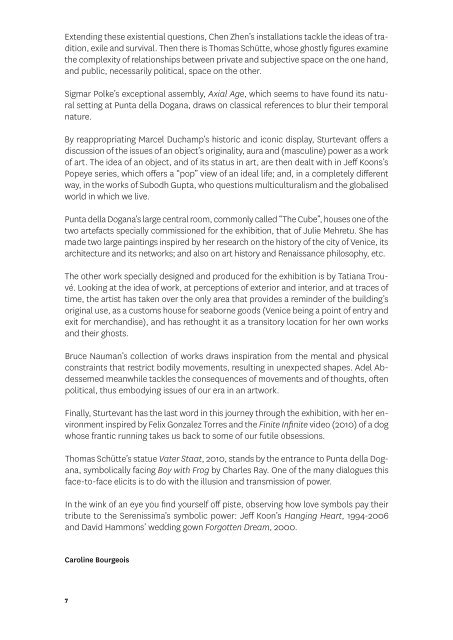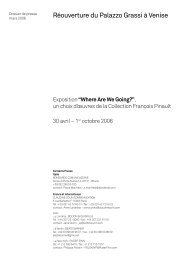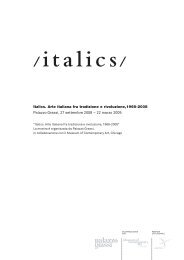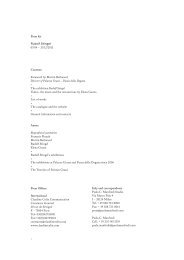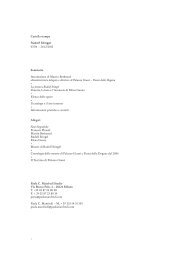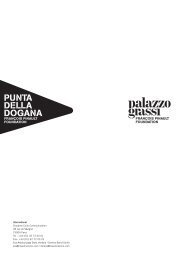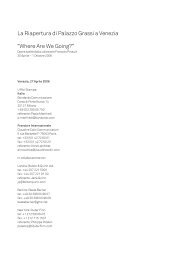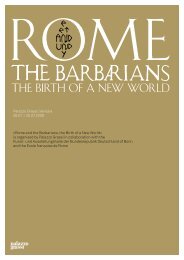Press Kit (pdf file - 445,85 Kb) - Palazzo Grassi
Press Kit (pdf file - 445,85 Kb) - Palazzo Grassi
Press Kit (pdf file - 445,85 Kb) - Palazzo Grassi
You also want an ePaper? Increase the reach of your titles
YUMPU automatically turns print PDFs into web optimized ePapers that Google loves.
Extending these existential questions, Chen Zhen’s installations tackle the ideas of tradition,<br />
exile and survival. Then there is Thomas Schütte, whose ghostly figures examine<br />
the complexity of relationships between private and subjective space on the one hand,<br />
and public, necessarily political, space on the other.<br />
Sigmar Polke’s exceptional assembly, Axial Age, which seems to have found its natural<br />
setting at Punta della Dogana, draws on classical references to blur their temporal<br />
nature.<br />
By reappropriating Marcel Duchamp’s historic and iconic display, Sturtevant offers a<br />
discussion of the issues of an object’s originality, aura and (masculine) power as a work<br />
of art. The idea of an object, and of its status in art, are then dealt with in Jeff Koons’s<br />
Popeye series, which offers a “pop” view of an ideal life; and, in a completely different<br />
way, in the works of Subodh Gupta, who questions multiculturalism and the globalised<br />
world in which we live.<br />
Punta della Dogana’s large central room, commonly called “The Cube”, houses one of the<br />
two artefacts specially commissioned for the exhibition, that of Julie Mehretu. She has<br />
made two large paintings inspired by her research on the history of the city of Venice, its<br />
architecture and its networks; and also on art history and Renaissance philosophy, etc.<br />
The other work specially designed and produced for the exhibition is by Tatiana Trouvé.<br />
Looking at the idea of work, at perceptions of exterior and interior, and at traces of<br />
time, the artist has taken over the only area that provides a reminder of the building’s<br />
original use, as a customs house for seaborne goods (Venice being a point of entry and<br />
exit for merchandise), and has rethought it as a transitory location for her own works<br />
and their ghosts.<br />
Bruce Nauman’s collection of works draws inspiration from the mental and physical<br />
constraints that restrict bodily movements, resulting in unexpected shapes. Adel Abdessemed<br />
meanwhile tackles the consequences of movements and of thoughts, often<br />
political, thus embodying issues of our era in an artwork.<br />
Finally, Sturtevant has the last word in this journey through the exhibition, with her environment<br />
inspired by Felix Gonzalez Torres and the Finite Infinite video (2010) of a dog<br />
whose frantic running takes us back to some of our futile obsessions.<br />
Thomas Schütte’s statue Vater Staat, 2010, stands by the entrance to Punta della Dogana,<br />
symbolically facing Boy with Frog by Charles Ray. One of the many dialogues this<br />
face-to-face elicits is to do with the illusion and transmission of power.<br />
In the wink of an eye you find yourself off piste, observing how love symbols pay their<br />
tribute to the Serenissima’s symbolic power: Jeff Koon’s Hanging Heart, 1994-2006<br />
and David Hammons’ wedding gown Forgotten Dream, 2000.<br />
Caroline Bourgeois<br />
7


